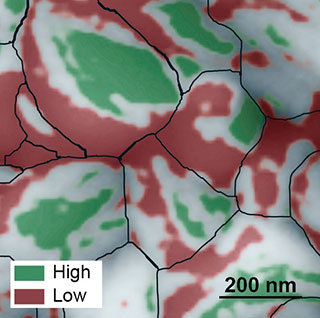| Posted: May 30, 2017 |
Nearly ideal performing regions in perovskite films could boost solar cells
(Nanowerk News) Solar cells made from specialized compounds, with the crystal structure of the mineral perovskite, have captured scientists’ imaginations. The cells are inexpensive and easy to make.
|
|
Even more intriguing, the efficiency at which perovskite solar cells convert light to electricity has increased more rapidly than any other material to date.
|
|
By taking a close look at the perovskite, a team at the Molecular Foundry can now differentiate high-performing areas on perovskite solar cells. These areas could lead to record high-efficiency solar cells (Nature Energy, "Facet-dependent photovoltaic efficiency variations in single grains of hybrid halide perovskite").
|
 |
| This atomic force microscopy image of the grainy surface of a perovskite solar cell reveals a new path to much greater efficiency. Individual grains are outlined in black, low-performing facets are red, and high-performing facets are green. A big jump in efficiency could possibly be obtained if the material could be grown so that more high-performing facets develop. (Image: Molecular Foundry, Berkeley Lab)
|
|
The discovery of these top-performing facets could hold the secret to highly efficient perovskite solar cells. The next step would be to make perovskite that only contained the most efficient facets.
|
|
A multidisciplinary team discovered a possible secret to dramatically boosting the efficiency of methylammonium lead iodide perovskite solar cells hidden in the nanoscale peaks and valleys of the crystalline material.
|
|
The team of scientists from the Molecular Foundry and users at the Joint Center for Artificial Photosynthesis, both at Berkeley Lab, found a surprising characteristic of a perovskite solar cell that could be exploited for even higher efficiencies, possibly up to 31 percent.
|
|
Using photoconductive atomic force microscopy having nanometer-scale resolution, the scientists mapped two properties on the active layer of the solar cell that relate to its photovoltaic efficiency. The maps revealed a bumpy surface composed of grains about 200 nanometers in length. Each grain has multi-angled facets like the faces of a gemstone.
|
|
Unexpectedly, the scientists discovered a huge difference in energy conversion efficiency between facets on individual grains. They found poorly performing facets adjacent to highly efficient facets, with some facets approaching the material’s theoretical energy conversion limit.
|
|
The scientists say these top-performing facets could hold the secret to highly efficient solar cells if the material can be synthesized so that only very efficient facets develop.
|

